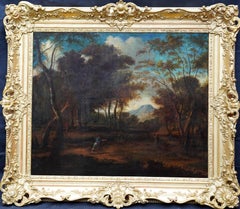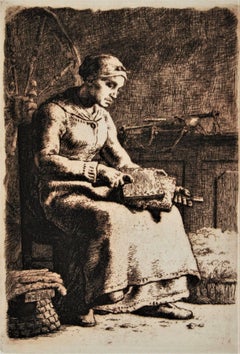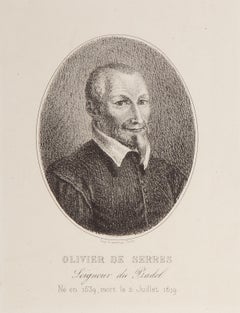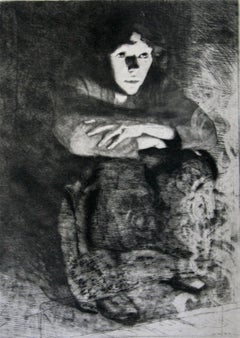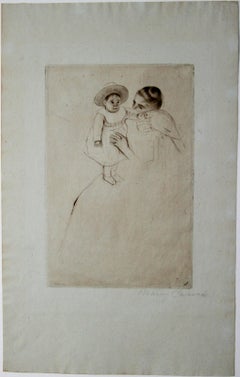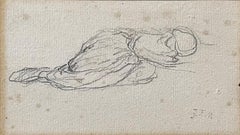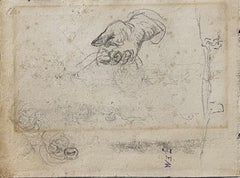Jean François Millet Art
to
1
2
1
1
Overall Width
to
Overall Height
to
1
3
1
1
1
3
1
3
2
1
1
1
1
1
1
1
2
1
1
1
1
6
10,083
2,777
1,380
1,375
2
1
3
1
Artist: Jean François Millet
La Boullie (The Porridge), Old Masters Drypoint Etching by Jean Francois Millet
By Jean François Millet
Located in Long Island City, NY
Etching printed in brownish black on light tan Chine collé, 1861. Image measures 6 x 5 inches, displayed in a 15.5 x 12.5 inch frame. Etched signature and date lower left. A very goo...
Category
1860s Impressionist Jean François Millet Art
Materials
Drypoint, Etching, Intaglio
Diana Hunting in Wooded Landscape - 17thC Old Master French art oil painting
By Jean François Millet
Located in Hagley, England
This superb French Old Master oil painting with excellent provenance is by Jean Francois I Millet. It was painted circa 1675 and is a figurative landscape depicting Diana hunting in ...
Category
17th Century Old Masters Jean François Millet Art
Materials
Oil
La Cardeuse (Woman Carding Wool)
By Jean François Millet
Located in Storrs, CT
La Cardeuse (Woman Carding Wool). c. 1858. Etching. Delteil, Melot 15. only state. 10 x 7 (sheet 12 3/8 x 9 1/2). Illustrated: Print Collector's Quarterly 25 (1938): 146; Keppel, The...
Category
1850s Barbizon School Jean François Millet Art
Materials
Etching
$2,400 Sale Price
20% Off
Portrait d'Olivier de Serres, Modern Lithograph by Jean-François Millet
By Jean François Millet
Located in Long Island City, NY
Jean-Francois Millet, French (1814 - 1875) - Portrait d'Olivier de Serres, Year: 1858, Medium: Lithograph, Image Size: 5 x 3.25 inches, Size: 9.5 x 6.25 in...
Category
1850s Modern Jean François Millet Art
Materials
Lithograph
Related Items
Dans les Cendres (In the embers)
By Albert Besnard
Located in Storrs, CT
Dans les Cendres (In the embers). 1887. Delteil catalog 67 state iii. State after the plate was cut down and a second figure eliminated (the two earlier states are of the greatest rarity). Etching, drypoint and roulette. 16 3/4 x 12 1/8 (sheet 19 1/2 x 14). Edition 50. Illustrated: Print Collector's Quarterly 9 (1921): 254. A very rich impression with plate tone and drypoint burr, printed on simili-japon. Provenance: Frederick Keppel & Co. This is one of the artist's most striking images. Signed in pencil. Housed in 25 x 20-inch archival mat, suitable for framing.
Paul Albert Besnard, was an impressionist painter. In 1866, the seventeen-year-old son of artist parents began his studies at the École des Beaux-Arts Paris. In 1874, Besnard won the important Prix de Rome, with which the academy distinguished young talent. A portion of the scholarship is a stay of several years in Rome. Besnard married Charlotte Dubray, a sculptress, during this time in Rome. The couple lived in England, where Besnard exhibited at the Royal Academy London, between 1881 and 1884. He became involved with English portrait painting during this period, which had a lasting influence on his work.
In the years that followed, Besnard broke with the academic tradition. In 1886, he presented the portrait of Madame Roger Jourdain...
Category
Late 19th Century Impressionist Jean François Millet Art
Materials
Drypoint, Etching
$1,250 Sale Price
37% Off
H 16.75 in W 12.13 in D 0.5 in
Hélène of Septeuil (enfant au perroquet) (child with a parakeet).
By Mary Cassatt
Located in Storrs, CT
Hélène of Septeuil (enfant au perroquet) (child with a parakeet). c. 1889-1890. Drypoint. Breeskin, 134.v. 9 3/8 x 6 1/4 (sheet 15 3/4 x 9 7/8). A rich impression with burr and plate...
Category
19th Century Impressionist Jean François Millet Art
Materials
Watercolor, Drypoint
$12,000 Sale Price
52% Off
H 20 in W 16 in D 1 in
Landscape Near Felday, Surrey
By Abraham Hulk the Younger
Located in Hillsborough, NC
Dutch/English artist Abraham Hulk the Younger (1851-1922) is most known for landscapes of the British countryside. This work is one of a pair (the second work is also available by s...
Category
Late 19th Century Old Masters Jean François Millet Art
Materials
Canvas, Oil
$1,960 Sale Price
30% Off
H 27 in W 22.75 in D 2.13 in
Original Algeciras Feria 1948 vintage Spanish travel lithograph poster
Located in Spokane, WA
Original vintage poster Algeciras Feria 1948 vintage Spanish travel poster. Archival linen backed in very fine condition, ready to frame. N...
Category
1940s American Modern Jean François Millet Art
Materials
Lithograph
$1,080 Sale Price
20% Off
H 39.5 in W 27.75 in D 0.05 in
Francis Bacon 'Personnage Couche' 1966 vintage lithograph
By Francis Bacon
Located in Brooklyn, NY
"Personnage couché" is a second edition lithograph poster by renowned artist Francis Bacon, originally published by Galerie Maeght in Paris in 1966. This striking artwork represents ...
Category
1960s Modern Jean François Millet Art
Materials
Lithograph
Billingsgate
By James Abbott McNeill Whistler
Located in Middletown, NY
Etching printed in dark brownish black ink on cream laid paper, 6 x 8 7/8 inches (152 x 226 mm); full margins. Extremely minor and unobtrusive band of toning along the top sheet edg...
Category
Mid-19th Century Impressionist Jean François Millet Art
Materials
Laid Paper, Drypoint, Etching
Allegory of Abundance
Located in New York, NY
Painted in collaboration with Hendrick van Balen (Antwerp, 1575 – 1632).
Provenance: Private Collection, Uruguay, since the 1930s.
The eldest son of Jan Br...
Category
17th Century Old Masters Jean François Millet Art
Materials
Copper
19th Century, Victorian, landscape , cows , Country House Samuel Lawson Booth
Located in York, GB
S Lawson Booth : Country House in extensive landscape with cattle in the foreground, oil on canvas signed and dated '98, 60cm x 90cm (35x23 inches approx image) size with frame appro...
Category
19th Century Old Masters Jean François Millet Art
Materials
Oil
$4,815
H 36.62 in W 44.89 in D 1.58 in
Portrait of Whistler with the Monacle.
By Paul César Helleu
Located in Storrs, CT
Portrait of Whistler with the Monacle. 1897. Drypoint. 13 3/4 x 10 1/4 (sheet 16 3/4 x 11 5/8). A carefully wiped impression with plate tone, from the cancelled plate (there were onl...
Category
19th Century Impressionist Jean François Millet Art
Materials
Drypoint
$1,600 Sale Price
20% Off
H 42 in W 20 in
Vachère au Bord de l'Eau
By Camille Pissarro
Located in Santa Monica, CA
CAMILLE PISSARRO (French 1830-1903)
VACHERE au BORD de l’EAU 1890 (Delteil 93 viii/viii)
Etching, unsigned as published in “Gazette des Beaux Arts”, Paris, 1890. On laid paper
Very...
Category
1890s Impressionist Jean François Millet Art
Materials
Drypoint, Etching
19th century oil, view London, the Thames, houses parliament, Francis Maltino
Located in York, GB
A fine pair of oil paintings, oil on board depicting views of the Thames one showing houses of parliament the other barges in busy shipping lane.
Framed and Glazed the size being 26 ...
Category
19th Century Old Masters Jean François Millet Art
Materials
Oil
$4,952 Sale Price
20% Off
H 16.15 in W 18.51 in D 1.97 in
Off Portsmouth Harbour 19th century oil , john callow
By John Callow
Located in York, GB
Off Portsmouth Harbour 19th century oil , john callow
A fine 19th century oil on canvas painting "off Portsmouth harbour "
signed and indistinctly dated 1844, the size of the paint...
Category
1840s Old Masters Jean François Millet Art
Materials
Oil
Previously Available Items
Study of the sleeping woman from "La méridienne"
By Jean François Millet
Located in Barbizon, FR
Study of the sleeping woman from “La meridienne”,
Black pencil drawing on paper (sketchbook), stamped from the widow's sale in 1894 (Lugt L.3728) lower left, Paper 9.2x13.2 cm, drawing 5.5x11 cm. Circa 1858.
The pictures include works related to the main subject:
- “La meridienne”, pastel and black...
Category
19th Century Barbizon School Jean François Millet Art
Materials
Paper, Pencil
H 3.63 in W 5.2 in D 0.04 in
Study of a hand and landscape, on the back, study of cow legs and hooves
By Jean François Millet
Located in Barbizon, FR
Black pencil drawing, stamp from the widow’s sale in 1894 (Lugt L. 3728), dimensions 10.5x14.2cm. This is a detail study of the hand of the peasant holding a lunge rein, represented...
Category
19th Century Barbizon School Jean François Millet Art
Materials
Pencil
H 4.14 in W 5.6 in D 0.04 in
Study of "Hylas and the nymphs", and on the backside, study of a peasant
By Jean François Millet
Located in Barbizon, FR
Black pencil drawing, stamped from the widow’s sale in 1894 (Lugt L. 3728), dimensions 7x10.2cm. It is most likely the first thought for this subject, circa 1846.
On the reverse si...
Category
19th Century Barbizon School Jean François Millet Art
Materials
Pencil
H 2.76 in W 4.02 in D 0.04 in
Le Semeur
By Jean François Millet
Located in New York, NY
A superb, dark impression of this lithograph, with strong contrasts and with all the subtle tonal variations distinct. Printed in brownish black on anti...
Category
1850s Realist Jean François Millet Art
Materials
Lithograph
The Abduction of the Sabine Women
By Jean François Millet
Located in New Orleans, LA
This dynamic oil on canvas represents one of the most recognized subjects of art history by one of the most important artists of the 19th century. Entitled The Abduction of the Sabine Women, it was composed by the great Jean-François Millet, a painter who is rightfully celebrated as the master of the peasant. Rather than a sower or field laborer, however, this early work captures a mythological narrative, a remarkable rarity for this painter. The dramatic story lends Millet the opportunity to display his command of figure, gesture and tone, revealing the earliest hints of the Realist style that would come to define his artistic genius.
This tempestuous scene of a woman being abducted by a man on horseback was composed at a critical point in Millet’s career. After studying at the École des Beaux-Arts under the tutelage of the history painter Paul Delaroche, Millet achieved modest success as a portrait and genre painter. Yet, by the 1840s, he sought to establish himself on a larger stage and began working on classical and historical compositions for the Paris Salon with emphasis on the human figure. The Abduction of the Sabine Women is among his finest compositions during this important period.
The narrative refers to an incident in Roman mythology when Roman men abducted women from a neighboring region — known as the Sabines — to take as wives. Under the direction of their founder Romulus, the Romans sought to form peaceful alliances with their neighbors and formally requested the rights of marriage with neighboring tribes. Rome's emissaries, however, were unsuccessful, so Romulus decided upon more drastic measures in order to ensure the security and future of his city. According to Levy, during the festival of Neptune Equester, the Romans successfully fought off the Sabine men and captured the young Sabine virgins, who they then married. Though the action initially resulted in war between the two nations, eventually peace was won thanks to the intervention of the Sabine women, who begged for unity between their families and their new husbands.
Throughout art history, The Abduction of the Sabine Women has been depicted by modern and old masters from Giambologna’s 16th-century marble sculpture to masterpieces in oil by Nicolas Poussin, Peter Paul Rubens, Jacques-Louis David and Pablo Picasso. Millet's treatment of the subject reveals his own influences, most specifically the great French Romantic painter Eugène Delacroix.
Although the subject pays homage to Jacques-Louis David’s Neoclassicism, Millet’s use of broad, quick brushstrokes and strong color notes of deep blue-greens and oranges displays a Romantic treatment. In assessing this painting, Millet expert Alexandra Murphy writes, “Only a few documented works survive from this period, and [the] painting is important as a reminder that Millet was looking to the example of Delacroix’s work even more than to his own master, Delaroche.”
Within a few years of creating the work, Millet turned to realistic subjects and moved to Barbizon, where he lived for the rest of his life. By the 1870s, the artist’s work was well established in Boston collections, but it wasn’t until the 1880s that Millet’s popularity spread to other parts of the country. In 1886, two important painting auctions took place in New York at the American Art Galleries: the sale of the Estate of Mrs. Charles Morgan...
Category
19th Century Realist Jean François Millet Art
Materials
Canvas, Oil
La Bouille - Original Etching by J. F. Millet - 1861
By Jean François Millet
Located in Roma, IT
Image dimensions 18.5x15.7 cm.
Original etching by J.F. Millet, signed on plate lower left "J.F. Millet 1861".
Very good conditions.
Ref. Delteil, 17; Degas, 215; Prouté, 1971.
This...
Category
1860s Naturalistic Jean François Millet Art
Materials
Etching
H 11.42 in W 7.09 in D 0.04 in
LES GLANEUSES
By Jean François Millet
Located in Santa Monica, CA
JEAN-FRANCOIS MILLET (1814 – 1875)
LES GLANEUSES, 1855 (Delteil 12 iii/iii)
Etching 7 ½ x 10". On tissue thin paper. Probably...
Category
1850s Barbizon School Jean François Millet Art
Materials
Etching
Paysan rentrant du fumier
By Jean François Millet
Located in Barbizon, FR
Etching, first state from IV, listed by L Delteil under n° 11
provenance: collection G.M. ADAMS ( stamp)
Category
Mid-19th Century Barbizon School Jean François Millet Art
Materials
Etching
L'hiver
By Jean François Millet
Located in Roma, IT
L'hiver is an original etching realized by Jean-François Millet and printed by Cornillot. Perfect conditions. Etching and aquatint representing a natur...
Category
1890s Modern Jean François Millet Art
Materials
Etching
La Grande Bergere
By Jean François Millet
Located in Santa Monica, CA
JEAN-FRANCOIS MILLET (1814 – 1875)
LA GRANDE BERGERE c. 1862 (Delteil 18 only state)
Etching on thinner laid paper, nice print ...
Category
1860s Barbizon School Jean François Millet Art
Materials
Etching
Les Bêcheurs (The Diggers).
By Jean François Millet
Located in Storrs, CT
Les Bêcheurs (The Diggers). 1855-56. Etching. Delteil, Melot 13.iii/iv. 9 1/4 x 14 (sheet 12 3/8 x 15 7/8). State with the name and address of the printer, "Paris Imp Aug Delâ...
Category
Mid-19th Century Barbizon School Jean François Millet Art
Materials
Etching
Couseuse
By Jean François Millet
Located in Palm Desert, CA
An etching by Jean Francois Millet, Couseuse depicts a woman sewing by a window.
Category
19th Century Modern Jean François Millet Art
Materials
Etching
Jean François Millet art for sale on 1stDibs.
Find a wide variety of authentic Jean François Millet art available for sale on 1stDibs. You can also browse by medium to find art by Jean François Millet in pencil, etching, drypoint and more. Much of the original work by this artist or collective was created during the 19th century and is mostly associated with the Old Masters style. Not every interior allows for large Jean François Millet art, so small editions measuring 5 inches across are available. Customers who are interested in this artist might also find the work of Theophile Narcisse Chauvel, and Charles François Daubigny. Jean François Millet art prices can differ depending upon medium, time period and other attributes. On 1stDibs, the price for these items starts at $3,000 and tops out at $15,290, while the average work can sell for $12,169.
Artists Similar to Jean François Millet
Questions About Jean François Millet Art
- 1stDibs ExpertNovember 20, 2024One of the most famous Realism paintings made by Jean-François Millet is called The Gleaners. It depicts three peasant women working in a field. Millet produced the oil painting in 1857, and it is now part of the collections of the Musée d'Orsay in Paris, France. Other notable works by the French artist include The Angelus, Shepherdess with Her Flock and Man with a Hoe. On 1stDibs, explore a range of Jean-François Millet art.
- 1stDibs ExpertJanuary 27, 2025Jean-François Millet is famous because of his Realist artwork. One of the founders of the Barbizon school, he was a major force in the 19th-century French Realist art movement. He is best known for his depictions of rural people working in the fields, such as The Gleaners, The Angelus and Shepherdess with Her Flock. Shop a collection of Jean-François Millet art on 1stDibs.
